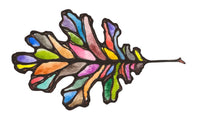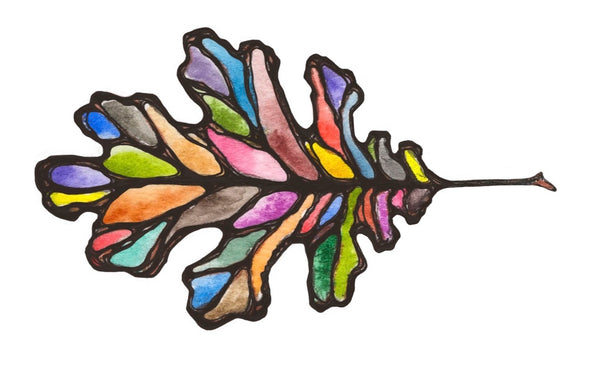
Understanding Color Temperature
Color temperature really threw me for a loop when I was first introduced to the concept. I had of course experienced the frustration of mixing muddy secondary colors from primary colors, so I was extremely motivated to push through and get a strong command of it. (I was tired of wasting time and paint!)
So, at first this can be a little confusing, but once you're on the other side it makes sense - and it's a total game-changer.
In this post I'm going to lay out a few key points that revolutionized my understanding of color and helped lead me to the "aha!" moment of really understanding color temperature - and, most importantly, allowed me to enjoy color mixing and begin to do it with ease.
Key #1: Think Spectrum Instead Of Wheel
First, let's change how we approach the classic color wheel. A color wheel is nothing more than a diagram. It is helpful for laying out very basic concepts, but I would encourage you to think more in terms of a spectrum instead of a wheel with spokes separating stagnant one-dimensional colors. Why? Because the "wheel" diagram gives a false idea that there is a "true" Red (or Yellow, Green, Blue etc.). So, these wheels are useful for generalizing, but need to be dismantled and broken down further for a clearer, deeper, and more accurate understanding of color.

On the left is a more or less traditional color wheel. On the right is a color wheel without color borders - the colors blend into one another in a circular spectrum. This is a more accurate way of viewing color because it shows incremental gradual transition.
Key #2: Red Is Not A Color - It's A Category
Next, think of the main color names (Red, Orange, Yellow, Green, Blue, Purple) as color categories under which a wide array of varieties are grouped. Instead of thinking of, say, "Red" as a color in and of itself or as a definitive example, think of it as a category that defines a certain general area of the color wheel or spectrum under which many different types of Red can be organized.

There is not really one universal "True Red" paint pigment against which all other hues of Red are to be compared. Instead, understand "Red" as a concept or term in color theory and as a category title under which all other reds (such as Red Ochre, Mayan Red, Naphthol Red, Alizarin Crimson, Cadmium Red, Pyrrole Red, etc.) can be filed.
Key #3: Temperature Refers to Location & Hue
"Temperature" is used as a term to describe a more specific location of a color on the color wheel. Identifying a color's temperature requires you to only observe a color's hue (or appearance).
Now we start to get to the meat of things...
Color Temperature: The Basic Concept

This diagram is your basic guide to color temperature.
When attempting to mix clean secondary colors, you want to choose versions of primary colors that are closer to each other on the color wheel. For example: Look at the diagram above. If you were wanting to mix a clean Green, you would select a Cool Yellow and a Cool Blue. To mix a clean Purple, select a Warm Blue and a Cool Red. Selecting primary colors that are closer to one another on the color wheel results in clean secondary colors.
But why? When you mix primary colors that are farther apart (e.g. Warm Red and Cool Blue in an attempt to mix Purple) you are essentially getting a third primary involved. (Whaaaat?!) A Warm Red is also an Orange-Red. In other words it leans towards Yellow. The second you get a third primary in the mix, things start to turn brown (or grey).
This can be confusing because you haven't added a third paint color or pigment to the mix. Identifying color temperature and selecting appropriate mixing colors relies on accurate identification of a color's hue. In this way, a Warm Red (or an Orange-leaning Red) doesn't secretly contain Yellow; it is just is more Yellow. It is a Yellowy-Red. Remember that there isn't one "This is exactly why it is important to think about colors as being part of a spectrum (instead of on a wheel) - and it is also why they can be confusing to discuss in words!
Troubleshooting
Many people get tripped up with color temperature because they think the temperatures need to match*. In other words, that you have to match Cool with Cool and Warm with Warm. This is precisely why understanding color mixing in terms of temperature can be confusing. Rely on the diagram above (and the little guide below) and note that pairing colors that are closer together on the wheel does not result in "matching" temperatures.
Here is your guide:
Warm Red + Warm Yellow = Clean Orange
Cool Yellow + Cool Blue = Clean Green
Cool Red + Warm Blue = Clean Purple
* You may hear the advice that color temperature needs to be in "agreement" which reads like "matching". Instead think "harmony" when you see "agreement".
But Wait... How Can Blue Be Warm?
Remember that temperature is only a shorthand term for referencing a more specific location on the color wheel. Instead of scrutinizing all of your blue paints wondering if they seem "warm" or not, ask yourself if they look more Green (cool) or more Purple (warm), more Yellow (cool) or more Red (warm).
Another Way To Think About It: Color Instead of Temperature
If thinking in terms of warm and cool colors just doesn't make sense to you or you find it's unnecessarily confusing (you won't be alone here!), then you can change the terminology to make the concept a little more straightforward.
Warm Red can be described as Orange-Red because a Warm Red is Red that leans towards Orange, and Cool Red can be described as Purple-Red because it leans towards Purple. Below, color temperatures have been translated.
Temperature to Color:
Warm Red = Orange-Red (or Yellow-Red)
Cool Red = Purple-Red (or Blue-Red)
Warm Yellow = Orange-Yellow (or Red-Yellow)
Cool Yellow = Green-Yellow (or Blue-Yellow)
Warm Blue = Purple-Blue (or Red-Blue)
Cool Blue = Green-Blue (or Yellow-Blue)
( If you find this at all confusing, think: "Orangey-Red" or "Greenish-Yellow".)
So your new mixing guide would read:
Orange-Red + Orange-Yellow = Clean Orange
Green-Yellow + Green-Blue = Clean Green
Purple-Red + Purple-Blue = Clean Purple
Notice that with these terms (unlike using temperature terms) you do get to using matching as a reliable mixing method! If you mix Orange-Red and Orange-Yellow you'll create a clean Orange! Whereas if you mix Purple-Red with Orange-Yellow, you'll mix a slightly muddy Orange, and if you mix Purple-Red with Green-Yellow you'll end up with a Brown.
Here is a diagram that illustrates the two types of terms:

In this diagram I am using the classic color wheel with spokes merely to visually illustrate terminology. Example: Warm Red = Orange Red. "Primary colors" are present to illustrate what a narrow view of color they are. As you can see, there are hues of Red beyond "Primary Red".
Another Way To Think About It: Draw A Line
You can literally cut through a lot of this terminology by drawing lines on your color wheel. See if that line has to travel a short distance or a long distance and through how many other colors. You will very quickly get an idea of whether your chosen primaries will mix a clean secondary.
Here are a few examples:

By mixing colors from these areas (Warm Red and Warm Yellow), the result will be a clean Orange. This is because these colors are already a little "Orangey". Remember that color mixing isn't magic (though it can sometimes seem like it!). A mixed color is simply the sum of its ingredients. The more aware you are of the colors you put into a color mixture, you'll be less surprised you will be with the result!

By mixing colors from these areas (Cool Red and Warm Yellow), the result will be less clean. The line is a little longer and you can see that the colors to which the arrows are pointing are farther away from one another. Blue is starting to enter the color equation through the selection of a Cool Red/Purple-Red (which said another way is Blue-Red).

This diagram clearly illustrates why a Cool Yellow and a Cool Red will not mix a clean Orange (despite the fact you are still mixing "Red" with "Yellow"!). Further, you will notice that Cool Red and Cool Yellow, as illustrated by this diagram, occupy opposite sides of the color wheel. In color theory, mixing two opposite colors (or complimentary colors) is the classic "easy" way to mix Brown!
It's Okay To Disagree!
FYI: it is completely okay to have your colors in temperature "disagreement"! Color Temperature is not a set of hard-and-fast rules. It is merely a system to guide your understanding. By having your temperatures in disagreement you will basically be "muddying the waters" and creating a Browner version by introducing that third primary color (which can be a very useful tool for subduing colors!). But now you can make that choice on purpose instead of by accident!
Where To Go Next
Just so you know, this is a lot to absorb if it's your first experience with this concept. The best step forward from here is to have a fresh look at the colors in your paint box. Take a few minutes to try and determine where your colors fall on the spectrum. Which Reds are Cool and which are Warm? Then start mixing. Make a few color wheels of your own (click here for a tutorial with free printables!). Mix a few combinations where the colors are in agreement and then mix a few where the colors are in disagreement! The more you mix the better!
And One Final Note:
There is a huge asterisk that goes along with this whole post in that any color system is imperfect because they seek to unite vast and varied fields of study (science, art, nature, and language) in one working model. Any dive deep into color theory will have you wondering about light waves, the retina of the human eye, the psychology of perception, geology, chemistry, Earth's atmosphere, and the Sun. That's a lot to tackle for anyone - let alone try to sum up in one diagram or one little blog post. So, there are concepts that I have breezed over and others that can be explained in other ways. My goal with this post is to illuminate the general theory of color temperature in a (reasonably) concise way.
I hope you found this useful!
As always, thank you for being here and wishing you happy painting!


